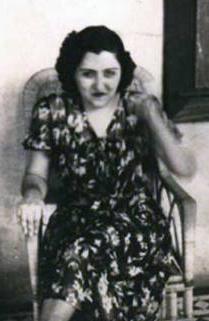Esmat Dowlatshahi
| Esmat Dowlatshahi | |
|---|---|
 | |
| Born | Esmat ol-Molouk Dowlatshahi 1905 Tehran, Sublime State of Persia |
| Died | 25 July 1995 (aged 89–90) Tehran, Iran |
| Burial | Behesht-e Zahra, Tehran |
| Spouse | |
| Issue | |
| House |
|
| Father | Prince Gholam Ali Mirza Dowlatshahi |
| Mother | Mobtahej Od-dowlah Morad |
Esmat Dowlatshahi (Persian: عصمتالملوک دولتشاهی; 1905 – 25 July 1995) was an Iranian royal and the fourth and last wife of Reza Shah.
Early life[edit]
Dowlatshahi was born in 1905.[1] She was a member of the Qajar dynasty.[1][2] Her father was Gholam Ali Mirza "Mojalal Dowleh" Dowlatshahi (1878–1934).[1] Her mother was Mobtahedj-od-Dowleh, daughter of Ebtehadj Saltaneh and Abou Nasr Mirza Hessam Saltaneh II.[1] Her paternal grandfather was Hessam-Saltaneh I. She had two brothers and one sister, Ashraf Saltaneh II.[1] Mehrangiz Dowlatshahi, member of the Majlis and Iranian ambassador, was her cousin.[3]
Marriage[edit]

Dowlatshahi and Reza Shah wed in 1923.[3][4] She was his fourth, last and favourite wife.[5][6] Reza Shah was the minister of war when they married.[3] From this marriage five children were born: Abdul Reza, Ahmad Reza, Mahmoud Reza, Fatemeh and Hamid Reza Pahlavi.[1] Her husband became Shah of Iran in 1925. However, it was her husband's second wife Tadj ol-Molouk who was given a public role as queen.[7] This situation did not make Tadj ol-Molouk happy due to her jealousy of Dowlatshahi which she disclosed in her memoirs.[7]
Dowlatshahi and Reza Shah lived in the Marble Palace in Tehran with their children.[5] She accompanied her husband to Mauritius when he was exiled there in September 1941, but she returned to Iran after a few months.[8]
Later life and death[edit]

Dowlatshahi stayed in Iran after the 1979 Islamic Revolution.[8] She visited the Museum of Reza Shah Pahlavi in Johannesburg, South Africa, in 1980.[9] She died on 25 July 1995.[10] She was buried in the Behesht-e Zahra cemetery, Tehran.[11]
References[edit]
- ^ a b c d e f Anne Commire; Deborah Klezmer, eds. (2007). "Esmat (d. 1995)". Dictionary of Women Worldwide: 25,000 Women Through the Ages. Waterford, CT: Yorkin Publications. pp. 613–614. ISBN 978-0-7876-9394-7.
- ^ Eileen Pollack (Fall 2004). "The Jewish Shah". Fourth Genre: Explorations in Nonfiction. 6 (2): 53. doi:10.1353/fge.2004.0041. S2CID 109585481.
- ^ a b c Camron Michael Amin (2002). The Making of the Modern Iranian Woman: Gender, State Policy, and Popular Culture, 1865-1946. Gainesville, FL: University Press of Florida. p. 115. ISBN 978-0-8130-3126-2.
- ^ Cyrus Ghani (2001). Iran and the Rise of the Reza Shah: From Qajar Collapse to Pahlavi Power. London: I.B.Tauris. p. 425. ISBN 978-1-86064-629-4.
- ^ a b Diana Childress (2011). Equal Rights Is Our Minimum Demand: The Women's Rights Movement in Iran 2005. Minneapolis, MN: Twenty-First Century Books. p. 40. ISBN 978-0-7613-7273-8.
- ^ "Iranian Princess Fatemeh Pahlavi". The Beaver County Times. London. 2 June 1987. Retrieved 24 November 2013.
- ^ a b Janet Afary (2009). Sexual Politics in Modern Iran. Cambridge: Cambridge University Press. p. 194. ISBN 978-1-107-39435-3.
- ^ a b Mehdi Jangravi. "Reza Shah's Wives". Institute for Iranian Studies. Retrieved 19 July 2013.
- ^ "South Africa Museum". Associated Press. 16 June 1980. Retrieved 23 February 2022.
- ^ "Reza Shah Pahlavi". Iran Chamber Society. Retrieved 19 July 2013.
- ^ "Behesht-e Zahra Cemetery". Harmsen. Archived from the original on 2 October 2013. Retrieved 1 August 2013.
External links[edit]
 Media related to Esmat Dowlatshahi at Wikimedia Commons
Media related to Esmat Dowlatshahi at Wikimedia Commons
